Childhood is the time when the body's immune system becomes established. It is during this period that a person meets most of the infectious diseases. Measles, chickenpox, mumps are the inevitable fate of any child before the introduction of vaccinations. At the present stage, many of these diseases can affect a person already in the adult state, manifested by unpleasant symptoms. One of these pathologies is rubella. What kind of treatment is needed for the patient? What preventive measures will prevent infection?
Contents
- 1 Rubella in children and adults
- 2 Classification of
- 3 Causes and factors of development: how the
- 4 virus can be transmitted First signs of the disease: how long the incubation period lasts
- 4.1 What the rash is like
- 4.2 Other possible manifestations
- 4.3 Clinical aspects of rubella - video
- 5 Diagnosis
- 6 How to treat the disease
- 6.1 Medication
- 6.1.1 Drugs for the treatment of symptoms of the catarrhal rubella period - table
- 6.1.2 Rubella preparations - photo gallery
- 6.2 Folk remedies for home use
- 6.2.1 Plants for rubella therapy - photo gallery
- 6.3 Related recommendations: Is it possible to wash
- 6.1 Medication
- 7 Prognosis, consequences and complications for men and women
- 8 Prophylaxis: vaccination, to whomit is impossible to inoculate
Rubella in children and adults
Rubella has been for a long time only children. Every child in his time necessarily suffered from this infectious disease. With the introduction of a wide range of vaccine prophylaxis, many people began to meet with this pathology in adulthood.
Rubella is an infectious viral disease characterized by the appearance of a specific rash, lymph node involvement and severe course in adults. The causative agent of rubella is a ruby virus from the Togaviridae family. For a long time the disease was actually identified with another infectious pathology - measles. For the first time the difference between these two pathological processes was described in 1829 by the German researcher Wagner.
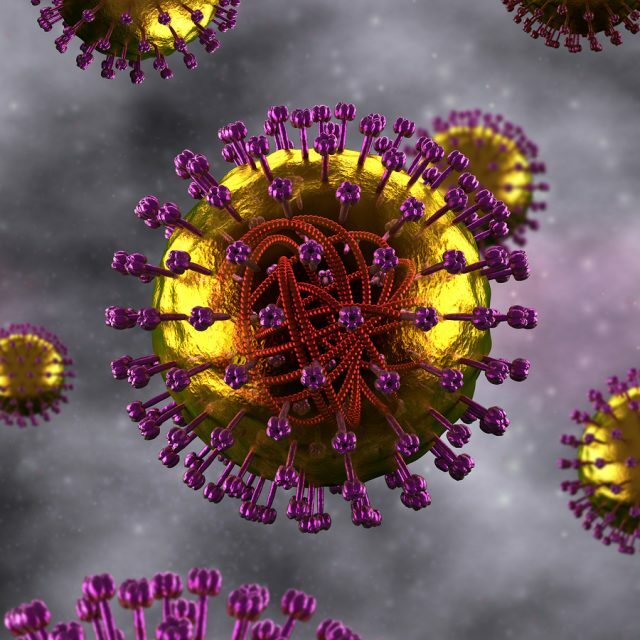
The causative agent of rubella refers to rubidium
Synonym for the disease: German measles. Rubella has long since ceased to be an exclusively childish disease. But if for many adults it turns out to be in most cases an annoying nuisance, then for pregnant women it is a real disaster.
Classification of
Rubella can occur in several basic forms:
- is typical, in which all symptoms and periods of the disease progress are pronounced;
- is stunted, characterized by a low degree of clinical manifestations;
- is asymptomatic, in which all the characteristic signs of rubella are absent.
The last two forms are especially dangerous, since the surrounding people, if there are no obvious signs of infection, are unaware of the possibility of infection.
Causes and factors of development: how the virus can be transmitted
The rubella virus circulates exclusively among people. The source of the disease is only a sick person both with a typical form of the disease, and with unexpressed clinical signs.
Infectious agent is transmitted by airborne droplets in close contact, coughing, sneezing. It must be remembered that a person who becomes ill becomes infectious long before the appearance of typical clinical symptoms. The danger to others he presents for a whole two weeks: ten days before the appearance of the rash and five days after.
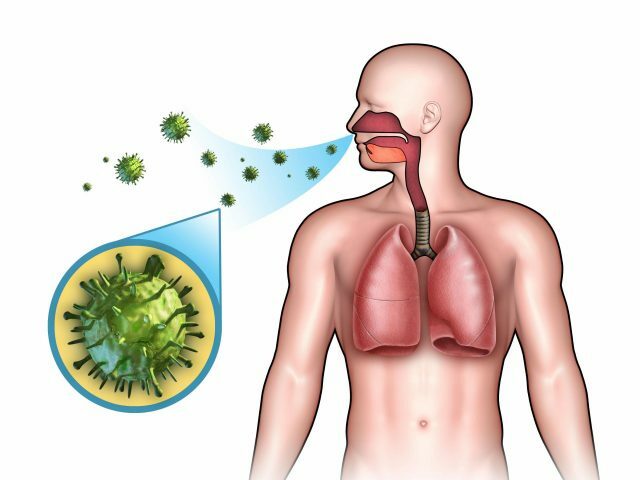
Aerosol pathway - the main mechanism of rubella infection
The rubella virus has chosen the most actively dividing cells of the human body as the place of settlement: the upper respiratory tract cover( epithelium) and the localized structures of the immune system - the lymph nodes.
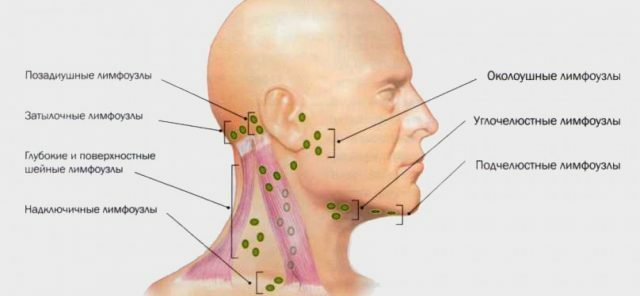
Rubella infection of the lymph nodes is a typical sign of
disease. When entering the nasopharynx or directly through the skin, the rubella virus quickly settles in these anatomical formations. The vital activity of the cell becomes the path of reproduction and assembly of viral particles. As the infectious agent leaves the blood stream, the total filling of the vessels with the causative agent( viremia) is formed, and as a result, the liver, spleen, brain, as well as the placenta and intrauterine fetus in pregnant women can become a springboard for further pathological process.
Circulation of the rubella virus in the vessels of the skin causes a typical rash( exanthema) for this disease. Specific rashes may also affect the mucous membranes of the body( enanthema).Reproduction of the virus in the lymph nodes leads to an increase in their size( lymphadenopathy).This type of reaction is natural as the body's response to the introduction of a foreign agent. However, as a barrier, the lymph nodes do not protrude for long, after which the virus enters the bloodstream and is transmitted to all organs.
The placenta is not a significant obstacle for the virus. With the current of blood, the pathogen penetrates into the cells of the fetus. In the early stages, the embryo contains many rapidly dividing anatomical structures. The destructive effect of the virus on these cells leads to various malformations of the fetus.
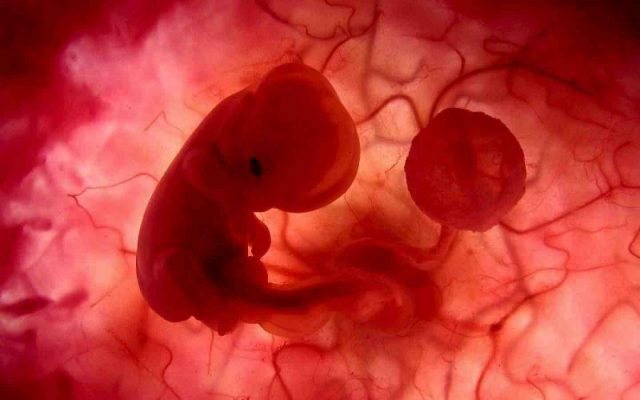
The intrauterine fetus suffers from the destructive effect of the
virus. The first signs of the disease: how long does the incubation period last?
The rubella flow in an adult is similar in many respects to that of children. The clinical picture of the disease is divided into three typical periods.
The incubation period from the moment of infection with the virus until the appearance of the first signs of the disease is from 10 to 25 days. Symptoms at this time are absent, however the causative agent has already developed the capture of a variety of body tissues.
The first manifestations of rubella mark the beginning of the catarrhal period. At this time the disease is no different from the common cold and is characterized by the appearance of the following symptoms:
- general malaise;
- weakness;
- aches in joints and muscles;
- redness of the conjunctiva of the eyeballs;
- nasal congestion;
- a sore throat;
- coughing and sneezing;
- increased body temperature.
At this stage, the virus is actively allocated to the external environment, and the patient poses a significant danger to others. The catarrhal period in adults has a long duration and severity of the clinical picture.
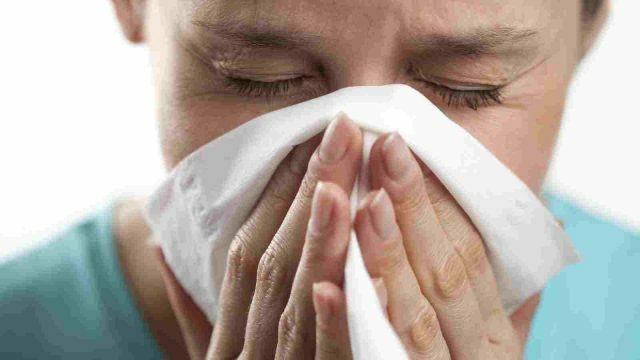
Cough, sneezing, sore throat - the main signs of the catarrhal period of rubella
What a rash is like
Nonspecific symptoms of the disease after a few days are replaced by a typical rash( exanthema).The latter is a collection of red flat spots with a regular round shape, with a rapidity spreading from the face and neck to the entire skin of the trunk and extremities. Sometimes rashes are accompanied by an itch of varying intensity. In adult patients, red spots are prone to fusion and the formation of extensive fields of the affected skin. Within 4 days, the rash disappears without a trace.
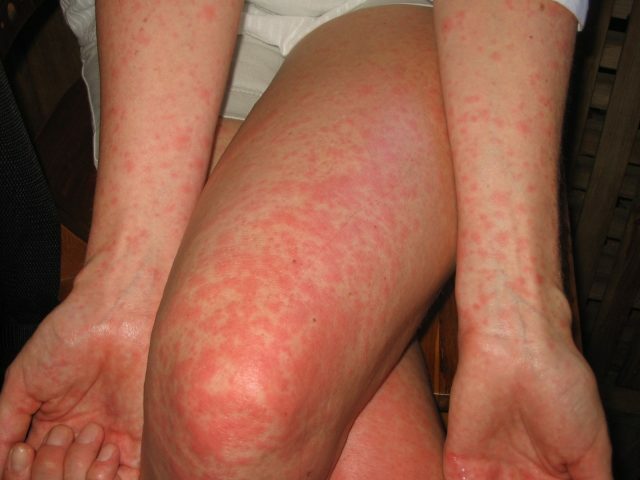
Rubella rash is a typical symptom of the height of the disease
Other possible manifestations
Against the background of the rash, there may be inflammatory joints( arthritis), nausea and vomiting. The enlargement of lymph nodes occurs in stages and very slowly. In some cases, adult lymphadenopathy may not develop at all. In pregnant women, the disease is characterized by similar symptoms.

Joint inflammation often occurs with rubella
In adults, the virus can affect the nervous tissue of the brain with the formation of meningitis and meningoencephalitis and the development of concomitant symptoms:
- excruciating headache;
- nausea and vomiting;
- stiff neck;
- disorders of muscle tone;
- disorder of skin sensitivity;
- meningeal symptoms.
Clinical aspects of rubella - video
Diagnosis
To establish the correct diagnosis, the following activities are necessary:
- interview and examination of the patient. It allows to determine the regular staging of the course of the disease and to reveal a typical spotted rash;
- neurological examination. It allows to reveal a violation of muscle tone and a disorder of skin sensitivity;
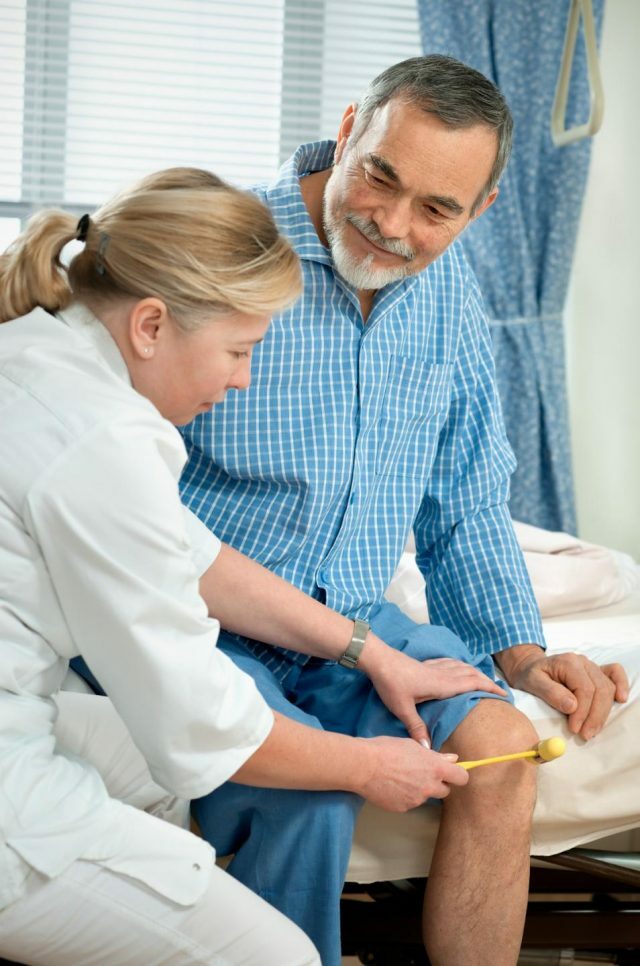
Neurological examination reveals symptoms of brain damage
- a common blood test. There is a decrease in white immune cells of the blood;
- determination of antibodies in the blood. It is carried out twice with an interval of several days. Large proteins from the class of immunoglobulins M indicate the first meeting with the rubella virus, and the increase in their number in the dynamics indicates a leaking acute form of the disease. Antibodies that are smaller in class G are a witness of a past illness or contact with a vaccine virus;
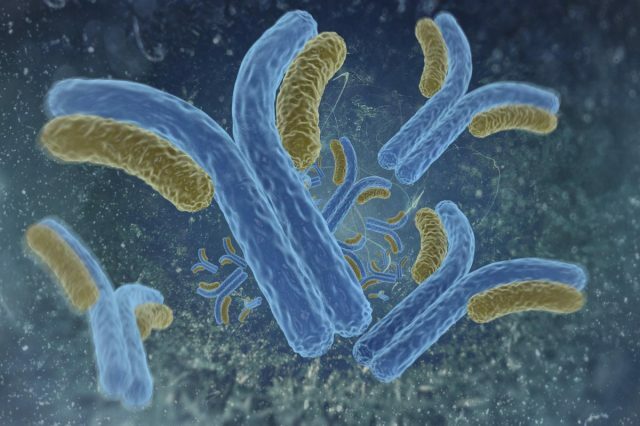
Antibodies - witnesses of the transferred disease
- computer( magnetic resonance) tomography. Allows to study in detail the structure of the brain with the appearance of neurological symptoms of the disease.
Differential diagnosis is performed with the following diseases:
- measles;Scarlet fever
- ;
- allergic reactions;
- is an enterovirus infection.
How to treat the disease
Rubella is treated under the guidance of an infectious disease specialist on an outpatient basis. Severe course of the disease may require hospitalization in the profile department of the hospital.
Drug treatment
In the catarrhal period, various drugs are used to relieve symptoms.
Preparations for the treatment of symptoms of the catarrhal rubella period - table
| Ingredient name | Active ingredient | Mechanism of action | Form |
| Xylen | Xylometazoline | Vasoconstrictor |
|
| Rhinostop | |||
| Vibrocil |
|
| |
| Sanorin | naphazoline | nasal drops | |
| Nasal Advance | oxymetazoline | ||
| Strepsils |
| topical antiseptic | resorption tablets |
| Tantum Verde | benzydamine |
| |
| Kameton |
| spray for topical use | |
| Faringosept | ambazone | lozenges | |
| Furatsilinom | nitrofurazone | solution for topical application | |
| Loratadine Loratadine | antihistamine tablets | ||
| Tavegil | clemastine | ||
| cetirizine |
| ||
| Bromhexine | bromhexine | expectorant | tablets |
| ACS | acetylcysteine |
| |
| Echinacea | Echinacea narrow-leaved extract | immunomodulating |
|
Rubella preparations - photo gallery
 Rhinostop is an available vasoconstrictive preparation
Rhinostop is an available vasoconstrictive preparation  Vibrocil is a preparation for the treatment of rhinitis with the allergic component
Vibrocil is a preparation for the treatment of rhinitis with the allergic component  Sanorin has a vasoconstrictive effect
Sanorin has a vasoconstrictive effect  Nasol Advance is an effective remedy for the common cold
Nasol Advance is an effective remedy for the common cold  Strepsils effectively cures sore throat
Strepsils effectively cures sore throat  Pharyngocept effectively removes impactionin the throat
Pharyngocept effectively removes impactionin the throat  Cameton is available in the form of an aerosol
Cameton is available in the form of an aerosol  Tantoum Verde is a local antiseptic effect
Tantoum Verde is a local antiseptic effect 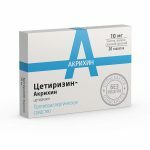 Cetirizine soothes itching
Cetirizine soothes itching  Echinacea strengthens the immune system
Echinacea strengthens the immune system Folk remedies for home use
With permission of a doctor in the treatment of rubella, the following recipes of traditional medicine:
Cowberry and wild rose. For the preparation of vitamin tea, mix the fruits of the plants in equal parts and brew. Apply the medication three times a day.Plants in rubella therapy - photo gallery
 Cowberry - a useful berry with rubella
Cowberry - a useful berry with rubella  Rose hips - a source of vitamin C
Rose hips - a source of vitamin C  Black currant is a deposit of vitamins
Black currant is a deposit of vitamins  St. John's wort has a calming effect
St. John's wort has a calming effect . Related recommendations: Is it possible to wash
Bed rest is mandatory only in case of a serious condition of the patient. Isolation of a sick person is carried out until the fifth day after the onset of the rash. Taking a shower with a stable condition and no fever is not contraindicated.
Prognosis, consequences and complications for men and women
Disease in adult men and women, as a rule, proceeds favorably. The most dangerous rubella for the fetus. In the first trimester of pregnancy, embryo infection with the virus leads to malformations in more than half the cases. With increasing time, this probability progressively decreases. In diagnosed rubella, a medical abortion is recommended for the mother during the first 12 weeks of pregnancy. On the possibility of conceiving a child, the transferred disease does not affect both men and women.
Among the other complications, the most important are viral pneumonia and meningoencephalitis.
Prevention: vaccination, who should not be vaccinated with
The main way to prevent disease is to administer the vaccine. This preparation contains a live attenuated form of the rubella virus. The vaccination schedule may differ in different cases.
Adult people who received a vaccine at the age of one and six years old are re-vaccinated at the age of 15-17 and 25-27 years. For women of childbearing age, artificially created anti-redness immunity is vital. Protective antibodies circulate in the blood for 10 years.

Vaccination - the main measure of rubella prevention
After 39 years of vaccination is not carried out.
In case of contact with an infected person, everyone who has not previously contracted rubella or who does not receive revaccination immediately gets vaccinated from his surroundings.
Contraindication to the introduction of the vaccine are:
- pregnancy;
- breast-feeding;
- immunodeficiency states;
- conducted chemotherapy treatment for oncological diseases.
After the introduction of the vaccine, various manifestations may occur. At the injection site, a localized allergic reaction may develop in the form of itching and reddening of the skin area. Among the common symptoms are:
- malaise;
- temperature increase;
- spotted rash;
- nausea and vomiting.
However, it should be noted that similar phenomena are observed in rare cases.
Rubella is a serious disease, common among children and adults, which is fraught with the development of complications. Vaccine prophylaxis is the basis for resisting infection with the virus and protecting the fetus from harmful effects.


